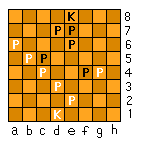MATHEMATICS 177 CHESS
The Middle Game: Pawn Structure
|
Def. 1 |
A pawn is passed if no opponent's
pawn could block or capture it, that is, if no opposing
pawn sits in the same or either adjacent file.
In the illustration at the right, white's 3 knight and rook pawns at
squares a6, b5, and g4 are the only passed pawns. |
|
Def. 2 |
Two pawns are connected if their files are
adjacent.
The idea here is that connected pawns can protect one another, at
least in the future, leaving the pieces free to perform more important
duties.
In the figure at the right, all pawns of both colors
are connected, except white's pawn at g4. |
|
 |
|
Def. 3 |
A pawn is isolated if it is not connected to another
pawn.
In the figure above, the only isolated pawn is white's pawn at g4. |
|
Def. 4 |
Two pawns are doubled if they occupy the same file.
In the figure above, only black's two king pawns are doubled.
In the rare event that 3 pawns occupy the same file,
they may be called doubled or tripled. |
|
Def. 5 |
You have a one pawn advantage (or n pawn advantage)
if you have one (or respectively, n) more pawn(s) than your opponent.
In the figure above, white has a one-pawn advantage. |
|
Def. 6 |
You have a one pawn disadvantage (or n pawn disadvantage)
if you have one (or respectively, n) fewer pawn(s) than your opponent.
In the figure above, black has a one-pawn disadvantage.(or respectively, n) more pawn(s) than your opponent. |
|
Def. 7 |
A pawn is backward if there is no friendly
pawn closer to the starting position in either adjacent file. Backward pawns are
difficult to avoid: white's pawn at e2 is backward. |
The idea is this: be constantly aware of what your position would look like
if the pieces were exchanged, one for one, until only the pawn structure
remained. When you perceive that you have the better pawn structure,
attempt to trade off all pieces to magnify and solidify that advantage.
If you perceive that your opponent has the better pawn structure, avoid
exchanging until you have used your pieces to gain the better pawn structure.
pawn structure
feature |
passed pawns |
2 or more
connected pawns |
isolated pawns |
2 or more
doubled pawns |
n-pawn
advantage |
n-pawn
disadvantage |
value for scoring
tonight's game |
+1
for each |
+1
total |
-1
for each |
-1
total |
+1 for each
extra pawn |
-1 for each
pawn behind |
In class, we will play a normal game, pausing three times to fill in the
empty boxes of the table BELOW. During this exercize, we will value the
various features of pawn structure using the table ABOVE.
|
move number |
Your pawn points |
Your opponent's
pawn points |
|
5 |
|
|
|
10 |
|
|
| 15
| |
|


